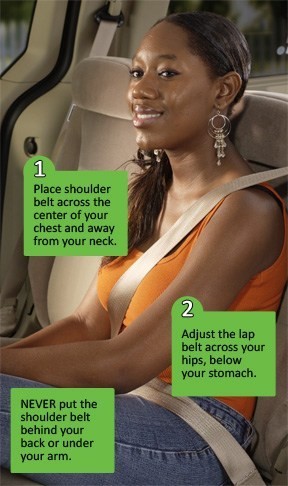Adults ages 18-34 are 10% less likely to wear seat belts than adults 35 or older (1).
The problem of low safety belt use:
- In fatal crashes for young adults ages 20-24, drivers were more likely to be buckled up than passengers (37% vs 30%). Overall, passengers have lower rates of seat belt use for all ages (2).
- Seat belts saved an estimated 14,955 lives in 2017 and an additional 2,549 lives could have been saved with 100% seatbelt use (3).
- You can be ticketed for not wearing a safety belt – even if you are sitting in the back seat. If you are in a state that does not have a primary seat belt law (police can’t pull you over just for not wearing a seat belt) check to verify if there is a law that requires anyone under the age of 18 to be buckled up. Visit here for more seatbelt laws.
- A seat belt does not protect you when it’s not worn properly (4).
 What to do about safety belts:
What to do about safety belts:
- When referring to safety belts, “properly worn” means with both straps snugly fitted to transfer the impact of the collision to the parts of your body that can take it – your hip bones and shoulder bones. With just the shoulder strap on, you can slide out from under the seat belt and be strangled, while the lap belt alone doesn’t keep your face from hitting the steering wheel (5).
- A safety belt is your best and last protection if you are in a crash.
- During a crash, being buckled up helps keep you safe and secure inside your vehicle. Being thrown out of a vehicle is almost always deadly (4).
- Airbags are designed to work with seat belts, not replace them. In fact, if you don’t wear your seat belt, you could be thrown into an opening airbag and be injured or even killed (6). An airbag increases the effectiveness of a seat belt by 40% (5).
- Get in the habit of always putting your safety belt on every time you get into a vehicle. No matter where you are sitting or the distance you are going.
- Ask your passengers to buckle up too. You are responsible for their safety.
Sources:
- CDC: https://www.cdc.gov/vitalsigns/seatbeltuse/index.html
- Insurance Institute for Highway Safety: https://www.iihs.org/topics/fatality-statistics/detail/teenagers
- NHTSA, Seat Belts: https://www.nhtsa.gov/vehicle-safety/seat-belts
- National Highway Traffic Safety Administration (NHTSA), 2019. Lives Saved in 2017 by Restraint Use and Minimum-Drinking-Age Laws. Available at: https://crashstats.nhtsa.dot.gov/Api/Public/ViewPublication/812683.pdf
- Northwestern State University, https://www.nsula.edu/documentprovider/docs/389/Seatbelts-why-u-should-use-them.pdf
- Safety Restore, https://www.safetyrestore.com/blog/will-airbag-work-without-seat-belt/
Updated August 2023